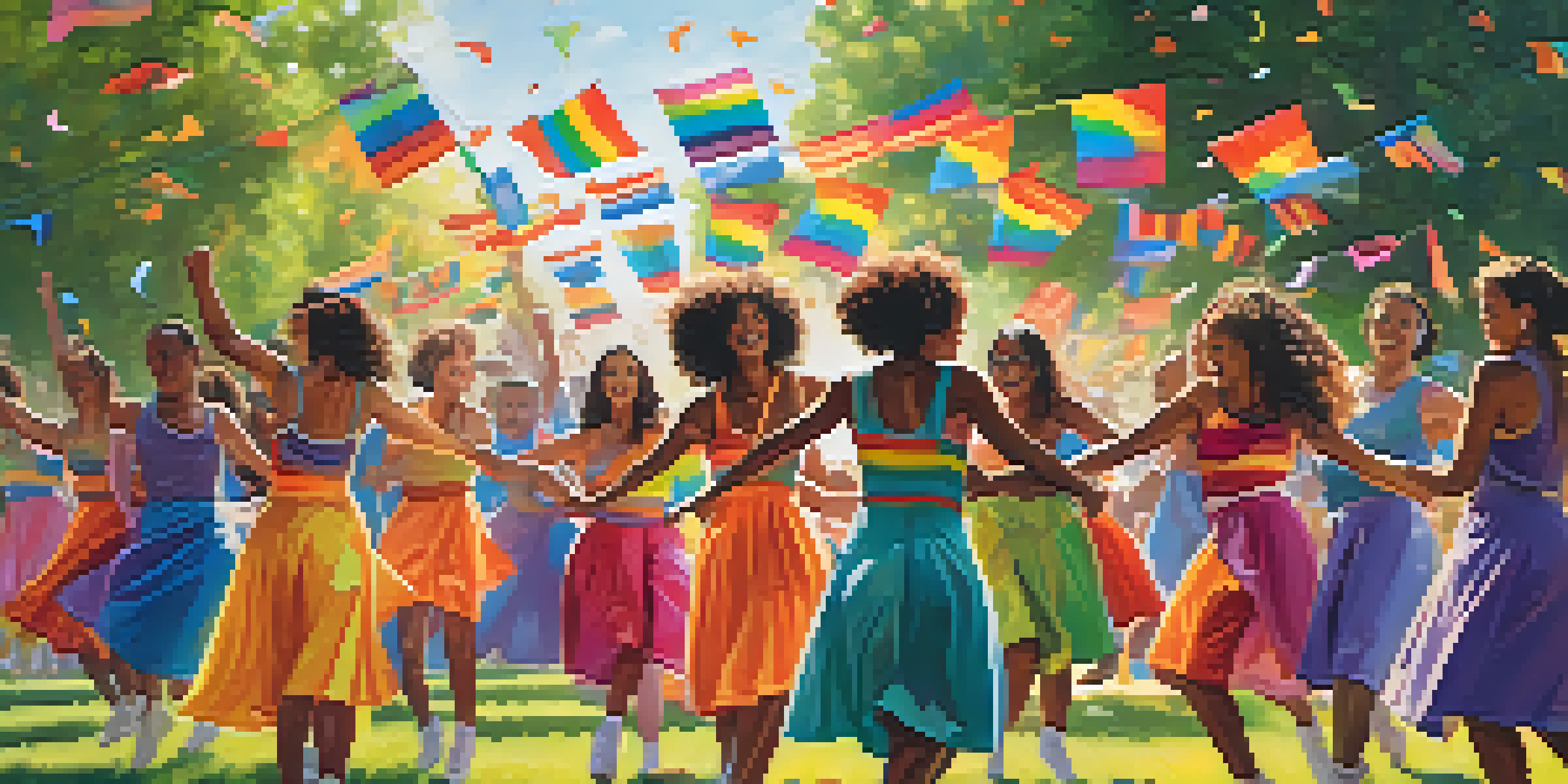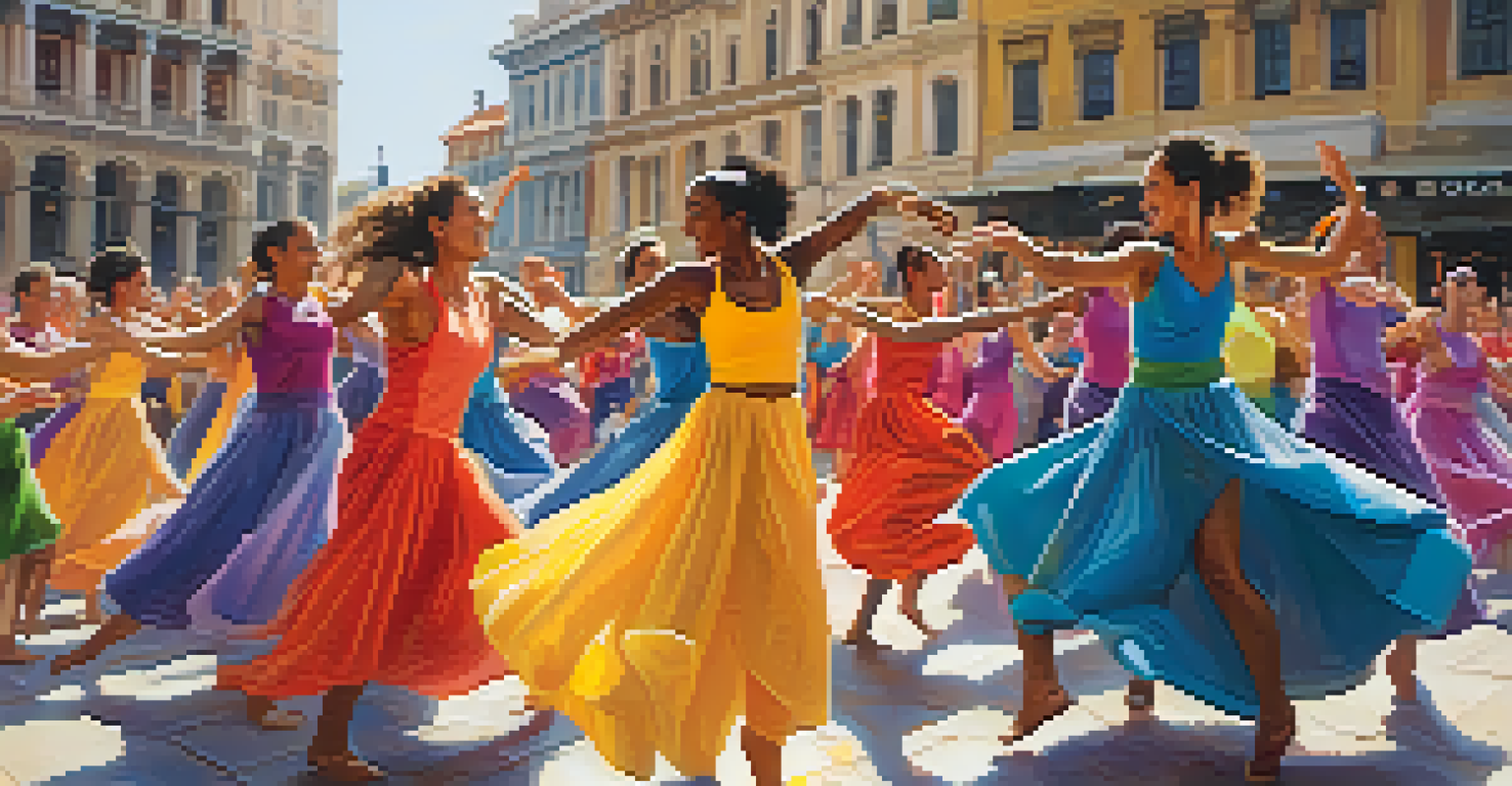Dance in LGBTQ+ Pride Celebrations: A Cultural Reflection

The Historical Roots of Dance in LGBTQ+ Culture
Dance has always played a significant role in the LGBTQ+ community, serving as both a form of expression and a means of connection. Going back to the early 20th century, places like the Stonewall Inn became sanctuaries where people could gather, dance, and openly express their identities. These gatherings were often filled with the rhythm of music, providing a backdrop for social change and community solidarity.
Dance is the hidden language of the soul.
The liberation movements of the 1960s and 70s saw dance evolve into a powerful tool for activism. Events like the Stonewall Riots were not just about protesting; they included energetic, defiant dancing that symbolized freedom and joy. This blend of celebration and resistance has continued to shape LGBTQ+ pride events, making dance an integral part of their culture.
Today, the influence of historical dance forms can still be seen in modern Pride celebrations. From drag shows to flash mobs, dance remains a vibrant method for showcasing identity and unity. It's a reminder of the struggles faced and the victories won, all while fostering a sense of belonging within the community.
Dance as a Form of Self-Expression in Pride Events
For many, dance is a deeply personal form of self-expression, allowing individuals to celebrate their identities in a unique way. During Pride celebrations, the dance floor becomes a canvas where people can express their true selves without fear of judgment. Whether it’s through individual styles or group performances, the act of dancing embodies the spirit of freedom and authenticity.

Different dance styles often reflect the diversity within the LGBTQ+ community. From voguing, which celebrates individuality and fierceness, to line dancing, which promotes togetherness, each dance form carries its own story and significance. This variety not only showcases the richness of LGBTQ+ culture but also encourages inclusivity among participants.
Dance as Expression in Pride
Dance serves as a personal and communal form of self-expression during Pride events, allowing individuals to celebrate their identities freely.
Moreover, dance provides a platform for storytelling. Individuals can convey their journeys, struggles, and triumphs through movement, creating a shared experience that resonates with many. This powerful form of communication deepens connections within the community and allows for a celebration of collective identity.
The Role of Music in Shaping Dance Culture
Music acts as the heartbeat of dance, especially within LGBTQ+ Pride celebrations. The selection of songs often reflects the themes of love, acceptance, and resilience, creating an emotional connection that inspires people to move. Iconic anthems, like those from artists such as Madonna and RuPaul, have become synonymous with Pride, energizing the crowd and encouraging participation.
Music brings people together, and dance is the expression of that unity.
Additionally, live performances by LGBTQ+ artists amplify this connection, turning dance floors into spaces of joy and solidarity. These performances often feature both established stars and emerging talent, highlighting the rich tapestry of LGBTQ+ artistry. The blend of live music and dance fosters an electrifying atmosphere that leaves a lasting impression.
Furthermore, the evolution of music genres, such as house and disco, has roots in LGBTQ+ culture, particularly in the nightlife scenes of the 70s and 80s. These genres not only shaped the soundtracks of Pride but also played a significant role in the development of dance styles associated with them. The synergy between music and dance is a testament to the community's creativity and resilience.
Dance as a Unifying Force in the LGBTQ+ Community
One of the most beautiful aspects of dance during Pride celebrations is its ability to bring people together. Regardless of age, background, or experience, the dance floor invites everyone to participate in a shared experience. This sense of unity fosters connections that can lead to lasting friendships and support networks within the community.
Dance breaks down barriers, encouraging individuals to let go of their inhibitions and join in the celebration. This collective joy is palpable and creates an atmosphere of acceptance and love. It's a moment where differences are celebrated, and people can embrace their authentic selves without hesitation.
Dance Unites the LGBTQ+ Community
The dance floor fosters connections and a sense of belonging, inviting participation and celebrating diversity within the LGBTQ+ community.
Moreover, participating in dance allows individuals to feel empowered and seen. Whether they are twirling alone or joining a group, the act of moving together sends a powerful message: everyone belongs. This unifying force of dance amplifies the message of Pride, reminding us that we are stronger together.
The Evolution of Dance Styles in Pride Celebrations
Over the years, dance styles showcased at LGBTQ+ Pride celebrations have evolved, reflecting broader cultural trends and the community's growth. Traditional forms of dance have been embraced while newer styles, such as twerking and hip-hop, have made their way into the Pride repertoire. This evolution keeps the celebrations fresh and relevant, appealing to a diverse audience.
As dance continues to evolve, so do the ways it is performed and experienced during Pride. Social media has played a significant role in this transformation, allowing dance challenges and viral trends to spread quickly. These platforms create opportunities for individuals to showcase their moves, further engaging the community and inspiring participation.
Additionally, the incorporation of technology, such as LED lights and visual effects, has enhanced the dance experience at Pride events. This fusion of art and technology captivates audiences, turning performances into unforgettable spectacles. The evolution of dance styles not only reflects changing trends but also embodies the spirit of innovation within the LGBTQ+ community.
Dance as a Medium for Activism and Awareness
Dance has transcended celebration and entered the realm of activism, serving as a powerful medium for raising awareness about LGBTQ+ issues. Choreographed performances during Pride often highlight social justice themes, shedding light on the challenges the community faces. This blend of art and activism engages audiences on a deeper level, prompting conversations about equity and inclusion.
For instance, flash mobs or choreographed pieces can deliver poignant messages about love and acceptance. These performances can be both entertaining and thought-provoking, encouraging spectators to reflect on their own beliefs and actions. Dance becomes a vehicle for change, inspiring individuals to join the movement for equality.
Dance Merges Activism and Art
Choreographed performances at Pride highlight social justice themes, using dance as a powerful medium for activism and raising awareness about LGBTQ+ issues.
Moreover, collaborations with advocacy organizations have become more common, using dance to raise funds and support for various causes. By harnessing the power of movement, these initiatives create a tangible impact, reminding us that celebration and activism can coexist beautifully. The intersection of dance and activism continues to be a vital aspect of LGBTQ+ Pride celebrations.
The Future of Dance in Pride Celebrations
As LGBTQ+ Pride celebrations continue to grow and evolve, so too will the role of dance within them. The future promises to embrace even more diverse dance styles, incorporating global influences that reflect the worldwide LGBTQ+ community. This expansion not only enriches the celebrations but also fosters greater understanding and appreciation among participants.
Additionally, the rise of virtual events has opened new avenues for dance engagement. With online platforms, individuals from all over the world can participate in Pride celebrations, sharing their dance moves and stories, creating a sense of global unity. This digital shift could redefine how dance is experienced during Pride, making it more accessible than ever.

Ultimately, the essence of dance in LGBTQ+ Pride celebrations will remain rooted in its ability to unite, empower, and inspire. As we look to the future, one thing is clear: dance will continue to be a vibrant expression of love, resilience, and community within the LGBTQ+ movement.